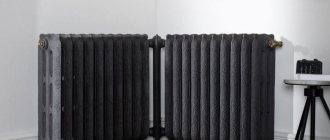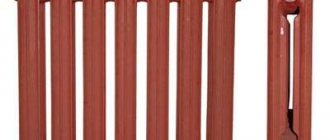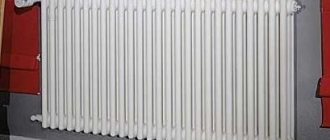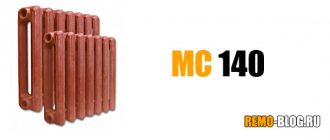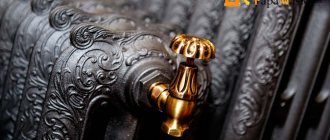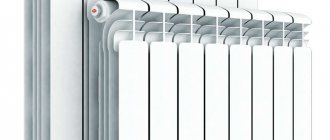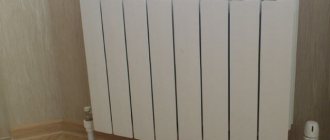Modern batteries attract the attention of homeowners with their ability to provide increased heat transfer. At the same time, it is hardly possible to call them an adornment of stylish interior design. It is often necessary to hide radiators behind decorative grilles and screens, thereby reducing the efficiency of the heating system.
Today, manufacturers offer a wide variety of design forms for modern cast iron radiators in retro style. A review of the models will help you make your choice.
Features of retro cast iron batteries
Cast iron batteries can look like steel and aluminum products in a modern industrial style. But the main advantage of the devices lies in the stylistic variety of section shapes and relief patterns on the cast surface.
Advantages
There are countless types of cast iron heat exchangers. You can choose a suitable device for almost any interior. Moreover, a trivial heating radiator becomes a separate original stylistic accessory.
Cast iron batteries have a number of other advantages:
- They do not require maintenance throughout their entire service life.
- Massiveness and large internal volume increase the thermal inertia of the heating system. This is an ideal option for use in combination with heated floors.
- Cast iron is resistant to corrosion, so thick walls will not rust even after fifty years of use.
- The variety of section sizes and connecting center distances makes it easy to select batteries for almost any interior.
- Large internal cavities are not clogged with mud deposits.
- The reliability of the design allows the operation of a steam heating system at a coolant temperature of up to 150 degrees Celsius.
- Manufacturers provide a guarantee of 10–15 years, but the actual service life most often exceeds half a century.
- Cast iron appliances are equally effective in heating systems with forced and natural circulation of coolant.
- Products are painted in a factory. High-quality enamel is resistant to mechanical damage, does not fade, or crack from repeated temperature changes.
In summer, the heating system must be filled with coolant to prevent air access and corrosion of metal surfaces. In practice, due to poor-quality shut-off valves and repair work, water leaks out and the metal rusts faster. Only cast iron sections successfully cope with this problem.
Flaws
Cast iron heaters must be installed taking into account their disadvantages. First of all, you should pay attention to the strength of the walls. If it is not possible to securely fix the brackets for suspended structures, then you need to choose floor-mounted radiators.
Other disadvantages:
- automatic temperature control systems must be adapted to the inertia of cast iron batteries;
- when used together with heated floors, it is necessary to connect the heaters to a higher temperature heat source;
- the operating pressure in the heating network should be within 4–6 bar;
- the large internal volume increases the time it takes to fill the system with water;
- inclined and horizontal stiffening ribs contribute to the accumulation of dust;
- heavy weight makes transportation and installation difficult;
- Retro-style products are more expensive than aluminum and steel ones.
When designing heating using retro radiators on legs, you should provide special channels under the floor for laying pipes. They must be as reliable as possible, since visual inspection of leaks will be impossible.
Advantages and disadvantages
Among the advantages of cast iron retro radiators, we note the following:
- Anti-corrosion resistance. Thanks to this feature, cast iron radiators can last 100 years.
- Resistance to various impurities contained in water.
- Durability.
- Slow cooling. Even if the heating is turned off, the batteries will give off heat for a long time.
- Cast iron radiators can operate at temperatures of 110°C.
- The surface of the retro-style battery models is covered with polyester enamel. This means that, if desired, the device can be repainted in any other color.
- Beautiful design.
The characteristics of cast iron radiators can be found here.
But there are also disadvantages:
- heavy weight, which may cause difficulties during installation and movement;
- It is difficult to remove dust between sections;
- high cost, products made in retro style are more expensive than radiators made of aluminum or steel.
The efficiency of batteries is influenced not only by the parameters, but also by the correct calculation and installation of the entire heating system.
Comparison with other types of batteries
Taking into account the lower cost of more technologically advanced modern heating devices made of steel and aluminum, one must take into account their lower durability. They rust faster from the inside, so they will have to be replaced more often during major repairs. Cast iron retro heating radiators are an excellent option for rooms decorated in an antique style using fine wood, marble, and expensive accessories.
Does it make sense to change a design that has been proven over many decades of good service? The operating principle and internal structure of cast iron batteries remain almost the same as a hundred years ago. But when the need arises to replace reliable heating devices with more modern ones, you need to pay attention to alternative options.
Heaters are made from the following materials:
- aluminum;
- steel;
- bimetal;
- cast iron.
Aluminum creates galvanic couples with other conjugated metals. This greatly accelerates corrosion and reduces trouble-free service life. In bimetallic radiators this disadvantage is especially pronounced.
With periodic heating using units for burning solid organic fuel, massive radiators retain heat longer. On the other hand, using aluminum or steel batteries can warm up the room faster.
Modern heating devices have other advantages compared to cast iron:
- improved thermal conductivity;
- slight inertia;
- lighter weight for easier installation;
- minimum internal volume for coolant;
- low cost.
The design features of the batteries made of steel and aluminum allow the installation of individual thermostats that automatically select the most economical room heating mode. In this case, it is necessary to monitor the quality of the coolant: install filters, soften the water, using chemical reagents.
In summer, the system must be completely filled with water. If the liquid leaks, then in conditions of humidity and access to oxygen, corrosion processes will significantly accelerate, the metal will rust, and major repairs will have to be done ahead of time with the replacement of individual sections or radiators.
Product Description
Cast iron and other radiators
Retro-style radiators are most often made of cast iron.
So if you want to get such a product, then you have two ways:
Among the old batteries you can find real masterpieces that need restoration
- Firstly, you can order or do-it-yourself restoration of a truly ancient model . Of course, you will have to work hard, and some adjustments will need to be made to the design, but in principle this task is quite realistic. The thing is that radiators produced in the late 19th and early 20th centuries are distinguished by a significant margin of safety, so that with appropriate treatment they can be brought back into working condition.
Note! The instructions recommend paying close attention to the intersection seams - they are the main source of leaks in restored models.
- Secondly, you can buy a modern product that was produced either according to old templates or according to new designs that imitate the design of retro batteries . The use of modern iron casting technologies makes it possible to produce very high-quality imitations of ancient models, so that outwardly the “remake” will be almost indistinguishable from the original.
High-quality cast iron can be indistinguishable from antique work
- It should be noted that such radiators are practically not produced en masse . This is why the price of such products can be an unpleasant surprise.
- In addition to cast iron structures in retro style, steel and aluminum models have also recently begun to be produced . However, here we are talking exclusively about imitation of the external form, since neither steel nor aluminum are suitable for the manufacture of heavy batteries from the beginning of the last century.
Copper wall battery
- Copper stands apart . Radiators made of copper pipes have undergone virtually no changes since their introduction, so such heating devices will look simply wonderful in a retro interior. Naturally, in this case, you need to choose products with a minimum number of modern technological improvements, as well as install stylized shut-off valves.
Shut-off valves made of copper
Advantages and disadvantages of retro models
If you decide to install a cast-iron retro radiator in your home, then it is important to be aware that it has both pros and cons.
Let's start with the strengths:
- The first advantage is the wonderful appearance of the products. Cast iron casting, complemented by high-quality painting, makes a lasting impression, so this battery will fit perfectly into any classic or Victorian interior. (See also the article Paint for heating pipes: features.)
Note! You should not hide such devices behind decorative screens, since this way we will not only lose the main advantage, but also worsen the heating.
Photo of an ancient device in the interior
- Another advantage is related to quality and reliability. If you don’t take risks by buying cheap imitations, but buy a retro model from a truly reputable manufacturer, then its safety margin will be impressive. In addition, cast iron itself provides good resistance to pressure changes.
- Finally, such radiators are well suited for heating large rooms. They heat up slowly, but maintain heat for a long time, which allows you to save fuel by periodically (for example, while you are at work) turning off the boiler.
Now let's move on to the cons:
- Firstly, products of this type are usually inferior to standard models in terms of operational parameters. So, to comfortably heat the room, you will have to buy more batteries, and the cost of heating itself will increase.
- Secondly, as we have already noted, retro models are quite expensive. This does not apply to restored radiators - but here your skill and time investment come to the fore.
Heavy models are rarely hung on the wall
- Thirdly, radiators are characterized by a significant mass, so they have to be mounted either on floor brackets or on very strong walls.
As a result, we get niche products that are worth purchasing only if it is necessary to create a certain style in the interior.
Recommendations for selection
The price of cast iron retro batteries depends on the design - the complexity of the cast surface, the bas-relief pattern, and the quality of painting.
The technical characteristics of radiators are important:
- height;
- width;
- depth of sections;
- thermal power value.
Maximum durability of a painted surface can only be achieved if certain conditions are met. After applying special dyes, the products are placed in thermal chambers for drying at high temperatures and controlled humidity. It is impossible to replicate this technology at home, so it is more profitable to purchase ready-to-install cast iron batteries.
For the initial calculation of the number of devices, the specific power coefficient of the heating system is used, which is taken equal to 100 W/m2. If the room area is 90 m2, then 9000 W of heat will be required. If the average thermal power of one section is 150 W, then you will need to buy 60 sections. They are connected and placed most often under window sills. If there are six windows with the same dimensions, then you get 6 heating devices from 10 sections.
When calculating the required number of heating radiators, specific climatic conditions must be taken into account. It is obvious that in the Arctic Circle the winter frosts are stronger than in the central part of Russia. Calculations are made for each room separately. Then a safety factor is added to the power of the heating devices, which is 10–15%.
Criterias of choice:
- The design of the battery must match the interior of the room.
- Cost is often a deciding factor.
- Heat dissipation directly affects the number of batteries. The greater the efficiency of the radiator, the fewer sections will be required.
- Reliability must be guaranteed by the manufacturer.
- Durability of cast iron radiators (tested by time).
- The size depends on the number of sections, as well as on the height of the window sill, where the batteries are most often installed.
- Weight is only important during transportation and preparation for installation. If the walls are made of lightweight concrete, then you need to choose a floor option with legs.
For heating a cottage, the operating pressure in the system is insignificant, but in multi-story buildings it reaches high values. It is worth taking this factor into account and looking at the permissible pressure specified by the manufacturer in the product data sheet.
Review of retro radiator manufacturers
High-quality cast iron casting, the original shape of the sections, and the stylishness of the patterned ornament create the unique attractiveness of the new type of cast iron batteries. Their price is higher than standard models. At the same time, the antique design of heating devices organically complements the classic, Gothic or English style of room decor.
You can buy retro cast iron radiators in a budget version or order an exclusive design with a bas-relief ornament, patination or artificial aging of the surface. The cost of products is greatly influenced by the scale of production. Some models are made only to order, which significantly increases their price. Especially when compared with the cost of standard Soviet-style products. For example, one Russian-made MS-140 section can be purchased for 380 rubles.
Retro Style
A Russian brand that produces several collections of cast iron radiators in various styles: Empire, Rococo, Classicism, Baroque. The company provides an ordering service for painting batteries in accordance with customer preferences. You can choose imitation antique silver, Gzhel, red gold, bronze and other options.
The cost of one section of a vintage two-channel Retro Style Anerli is 16,367 rubles.
A battery of 5 low-profile multi-channel Retro Style Bolton sections can be purchased for RUB 19,219.
The Retro Style Chester cast iron radiator costs 41,696 rubles for 5 sections.
Prices for cast iron radiators Retro Style
cast iron radiators Retro Style
Guratec
The high-quality heating devices made in Germany are designed in a retro style. The surface of the sections is protected with powder paint that is resistant to mechanical damage. Before being sent to consumers, products are tested on hydraulic stands.
The Guratec Fortuna series radiator, priced from 140 euros per section, is decorated with a beautiful vine ornament, images of dragons, lions and angels. The patterned surface of the batteries, painted to match the decor, will decorate a classic interior.
Prices for cast iron radiators Guratec
cast iron radiators Guratec
Roca
The representative of the Spanish industry has a hundred-year history of development. The first products were produced by the plant in 1917. Manufactures a diverse range of heating devices from aluminum, steel and cast iron with a retro design. The Epoca model is popular - a battery of 6 cast iron sections, which sells for 29,420 rubles.
Demir Dokum
The factories of the Turkish manufacturer are equipped with automated production lines in accordance with modern European standards. Now you can buy in Moscow any of six models, which are presented in different standard sizes.
The products are distinguished by excellent performance characteristics, have a magnificent appearance, so they can decorate any interior. One section of the Demir Dokum Historic model costs 3,981 rubles.
Prices for cast iron radiators Demir Dokum
cast iron radiators Demir Dokum
Conner Modern
The products of the Russian manufacturer in the Art Nouveau style have good heat transfer rates. Products are manufactured using modern technologies. At a very reasonable price, domestic cast iron radiators are not inferior to European ones in terms of workmanship. The cost of a six-section Modern-500 series radiator is 4,080 rubles.
The final price of a cast iron retro battery depends not only on the number of sections, the popularity of the chosen model, and the product manufacturer. A kit completely ready for installation will cost more, but will serve more reliably and longer.
Cast iron radiators from RUB 1,380.
Advantages of cast iron radiators
The only ones made in Russia
The entire production cycle of cast iron radiators is localized in the Urals. We are the only ones producing cast iron radiators in Russia and from Russian raw materials
Decorate the interior
Cast iron radiators are not only energy efficient but also an important part of the interior
Doesn't dry the air
Heat radiates from the entire surface of the radiator with low convection. This makes the air in the apartment less dry and more favorable
Will not rust or become clogged Cast iron radiators are not demanding on the quality of the coolant and have an unlimited service life
High thermodynamic inertia
Radiators retain heat longer and smooth out changes in coolant temperature
Competitive price
We produce radiators, and do not resell. Without intermediaries and with minimal logistics costs
Russian production of cast iron radiators using imported equipment. Buy in Moscow and other cities.
CALCULATION OF THERMAL POWER OF HEATING RADIATORS BY SQUARE METERS
Radiator power is the thermal energy of the radiator, measured in Watts (W).
So, there is a direct connection between the heat loss of the room and the power of the radiator, i.e. if the room has a heat loss of 2400 W, then the radiator must be selected with the same power of 2400 W. But the temperature of the radiator can be in the range from 40-90 ° C and, accordingly, the power of the radiator will be different at different temperatures.
But many, unfortunately, will not understand how to find out the heat loss of a room... There are simple calculations for determining the heat loss of a room. They will be written about later.
At what temperature will the radiator heat up?
If we have a private house with plastic pipes, then the temperature of the radiators will range from 45-85 degrees. Average temperature is 70 degrees. Maximum temperature 85 degrees.
If you take an apartment with central heating, then from 40-95 degrees. Maximum temperature 95 degrees. At the moment the central heating temperature is weather dependent. This means that the temperature of the central heating coolant depends on the temperature outside. When it gets cold outside, the coolant temperature is higher and vice versa. Therefore, the power of radiators according to SNiP is calculated at ∆70 degrees. But this does not mean that you need to choose this way. Management companies and similar organizations set the power to heat your apartment less and save money on heat energy, and take money from rent as usual. Today it is not prohibited to change the radiator to a more powerful one. But if your radiator takes away a lot of heat and there are complaints about the system, then measures will be taken against you.
Let's assume that you have decided on the coolant temperature and radiator power
Given:
Average radiator temperature 60 degrees
Radiator power 1500 W
Room temperature 20 degrees.
Solution
When you search and ask for a radiator with a power of 1500 W, they will offer you a radiator with a power of 1500 W with a temperature difference of ∆70 °C. Or ∆50, ∆30…
What is the temperature difference of a radiator?
Temperature difference is the temperature difference between the temperature of the radiator (coolant) and the temperature of the room (air)
The radiator temperature is the conditionally average temperature of the coolant. That is
Let's assume that there is a series of radiators of certain capacities with a temperature difference of ∆70 °C.
Model 1, 1500 W
Model 2, 2000 W
Model 3, 2500 W
Model 4, 3000 W
Model 5, 3500 W
It is necessary to select a radiator model with an average coolant temperature of 60 degrees.
In this case, the temperature difference will be 60-20=40 degrees.
There is a formula for recalculating the power of radiators:
Uph – actual temperature difference
Un – standard temperature difference
More details about the formula: Calculation of radiator power. Standards EN 442 and DIN 4704
Solution
Answer: Model 5, 3500 W
Radiators Trend1 and Trend2
How do you like modern design, but with retro filling? Trends differ from other radiators in that they are made not in retro style, but in the style of modern radiators, such as aluminum and bimetal. However, these radiators still have a retro style and it lies in the fact that they are made of natural, real cast iron in the best traditions of retro style. These radiators are in great demand not only because of their low price, but also because they fit into modern renovations, into any style, by the way, including retro. Because, if you look closely, they have a rough structure between the sections and the combination with retro-style taps (valves) can give odds to many retro-style radiators. These radiators are suspended only; they have a pass-through or side connection. Nipple 1 inch. Dimensions Trend1: center distance: 500 mm, height: 585 mm, depth: 90 mm, width: 60 mm, section weight: 5.1 kg. Dimensions Trend2: center distance: 500mm, height: 580mm, depth: 80mm, width: 60mm, section weight: 4.9kg.
On our website RETRORUSSIA.RF you can purchase retro radiators Trend1 and Trend2, and you can also choose any of our products, or call: 8-800-700-70-71. We are always glad to see you!
#cast iron radiators #antique radiators #cast iron #retro radiators #retro batteries #retro heating #cast ironheat #radiators #batteries #heat #retrointerior #loft #vintage #retro Russia #retrolebedeva @retrolebedeva
Today we are talking about plugs for cast iron radiators.
Choose our product on the website RETROROSIYYA.RF or call: 8-800-700-70-71.
We are always glad to see you!
#retro style #cast iron radiator #cast iron #retrolebedev #retrorussia @retrolebedev #retrorepair #retrohouse
Rules for installing retro batteries
You can begin installing radiators only after checking the connections between sections. Tightness is ensured by gaskets made of heat-resistant rubber or paronite. The batteries are placed at a distance of 30–50 mm from the wall to ensure convective heat exchange. Systems with natural circulation are installed with pipes sloping in the direction of coolant movement.
To carry out proper installation, you must be guided by the “Building Norms and Rules” (SNiP):
- Determine the exact location for installing the radiators.
- Install brackets for pendant batteries.
- Equip radiators with plugs, air release valves, shut-off valves, and adapters.
- Install the heating devices in their places.
- Install the piping.
- Connect the radiators to the inlet and outlet pipes of the heating system.
- Remove the protective film from the surface of the sections.
The connection of heating devices to the heating system depends on the chosen flow pattern of the coolant, as well as on the location of the main pipeline in multi-storey buildings: with lower wiring in the basement or with upper wiring - on the technical upper floor.
There are three main ways to connect radiators:
- Bottom connection. Most often used in cottages. This method allows you to hide pipes under the floor and favorably emphasizes the aesthetics of designer radiator models.
- Lateral connection. Used for heating systems in multi-storey buildings. The supply pipe is connected to the upper futark, and the return pipe is connected to the lower one. This is the most efficient connection scheme in terms of heat transfer from radiators.
- Diagonal method. It is used for two-pipe horizontal distribution for one-story buildings. The supply pipe is connected to the top of the heating device on one side, and the return pipe is connected to the bottom on the other side.
To connect radiators to the pipes of the heating system, valves and taps are used, stylized as antique designs. Products of this type are manufactured by Italian companies Carlo Poletti and Rubinetterie.
Retro radiators - cast iron heating radiators (batteries)
Cast iron retro radiators are popular cast iron heating radiators in Retro style. They are represented by a wide range of heating devices of different brands - Guratec (Germany), Viadrus (Czech Republic), Exemet (Russia), RetroStyle (Russia), Demir Dokum (Turkey), Fakora (Poland).
Radiators in retro style differ not only in design, shape, style of patterned ornaments, color, but also in their technical characteristics - height, depth, width, thermal power.
Cast iron retro batteries can have a final finishing color made in production or supplied primed. Radiators in the ground make it possible to paint them in any color you choose with special heat-resistant paints or decorate them using various techniques.
Retro radiators are an ideal solution for heating rooms made in the style of Italian Baroque, French Rococo, imperial style of the era of Napoleon I - Empire, as well as in modern styles - Loft, Industrial, High-tech.
Among the variety of antique radiators, you can always buy models that will harmoniously match other stylistic solutions of the interior, such as Classicism, Renaissance and even Gothic.
Retro radiators up to 500 mm high
| Hellas (410 mm) | Apollo (466 mm) | Tower (480 mm) | Rococo (490 mm) |
Retro radiators 500-700 mm high
| Merkur (506 mm) | Artdeco (506 mm) | Historic (510 mm) | Diana (600 mm) |
| Hellas (610 mm) | Bohemia (640 mm) | Bohemia R (640 mm) | Tower 4066 (660 mm) |
| Retro (661 mm) | Historic (661 mm) | Gothica (663 mm) | Versailles (675 mm) |
Retro radiators 700-900 mm high
| Dragon (735 mm) | Apollo (750 mm) | Jupiter (752 mm) | Artdeco (760 mm) |
| Merkur (760 mm) | Retro (760 mm) | Historic (760 mm) | Rococo (790 mm) |
| Leicester (790 mm) | Fortuna (800 mm) | Radiator |
Retro radiators over 900 mm high
| Apollo (950 mm) | Historic (955 mm) | Retro (954 mm) | Rococo (960 mm) |
| Mangus (980 mm) | Oxford (985 mm) | Bohemia (990 mm) |
Valves for connecting retro radiators to the heating system
| Carlo Poletti valves | SRRubinetterie valves | Classic Comfort valves |
To connect cast-iron retro radiators to the pipes of the heating system, designer valves and taps from the Italian companies Carlo Poletti and SR Rubinetterie are used. They blend very organically with these radiators.
Retro radiators are heating devices, sections of which are made using artistic cast iron. The relief ornaments and patterns on the side surfaces of the sections are based on ancient models of European and North American cast iron radiators of the late 19th and early 20th centuries.
Cast iron radiators in retro style, installed on the floor (on legs), are not only a source of heat, but also represent solid and high-quality interior items.
In recent decades, due to the massive advance of heating radiators made from other, cheaper and easier to produce metals and alloys, there has been a tendency to reduce factories producing cast iron radiators. And perhaps the time will come when a beautiful patterned cast iron radiator will become a real family heirloom or even an antique in your home.
Restoration of old radiators
High-quality cast iron products sometimes last more than 100 years. During the major reconstruction of ancient buildings, valuable rare pieces of heating equipment made in the 20th or even 19th century are discovered.
To give a second life to an old cast iron battery, you need to perform a few simple operations:
- Remove the radiator and move it outside the building.
- Disassemble the device into separate sections. A special liquid will help soften rusted threads.
- Remove old paint from the surface. While heating the section evenly with the flame of a blowtorch, remove many years of deposits with a spatula and a flat-head screwdriver. Residues are cleaned off with emery cloth.
- Rinse the internal cavities of the sections with tap water under maximum pressure.
- Drain the water and dry the radiator.
- Assemble the battery using new nipples and paronite gaskets, install plugs.
- Degrease all surfaces with solvent.
- Then prime and paint the radiator.
- After complete drying, install and connect the battery.
The updated cast iron radiator will be able to serve its intended purpose for many years to come. At the same time, it will still delight its owners with its unique design. Read about bricks for stoves on our website.
